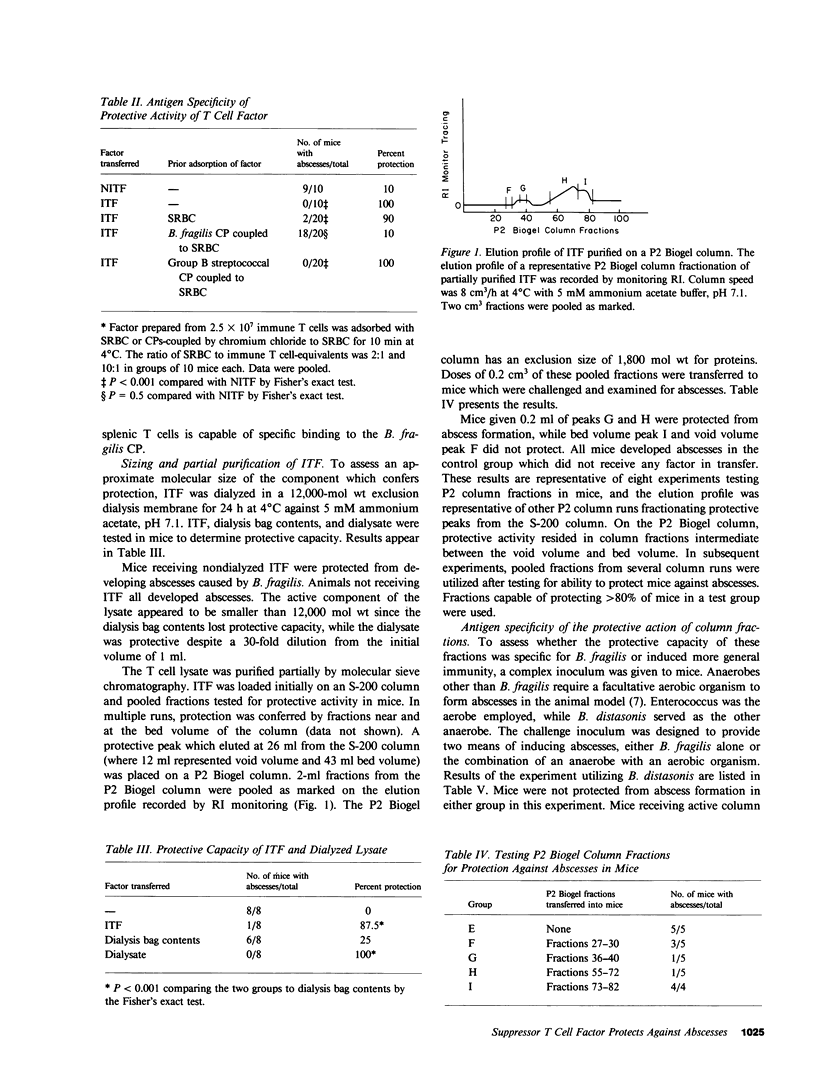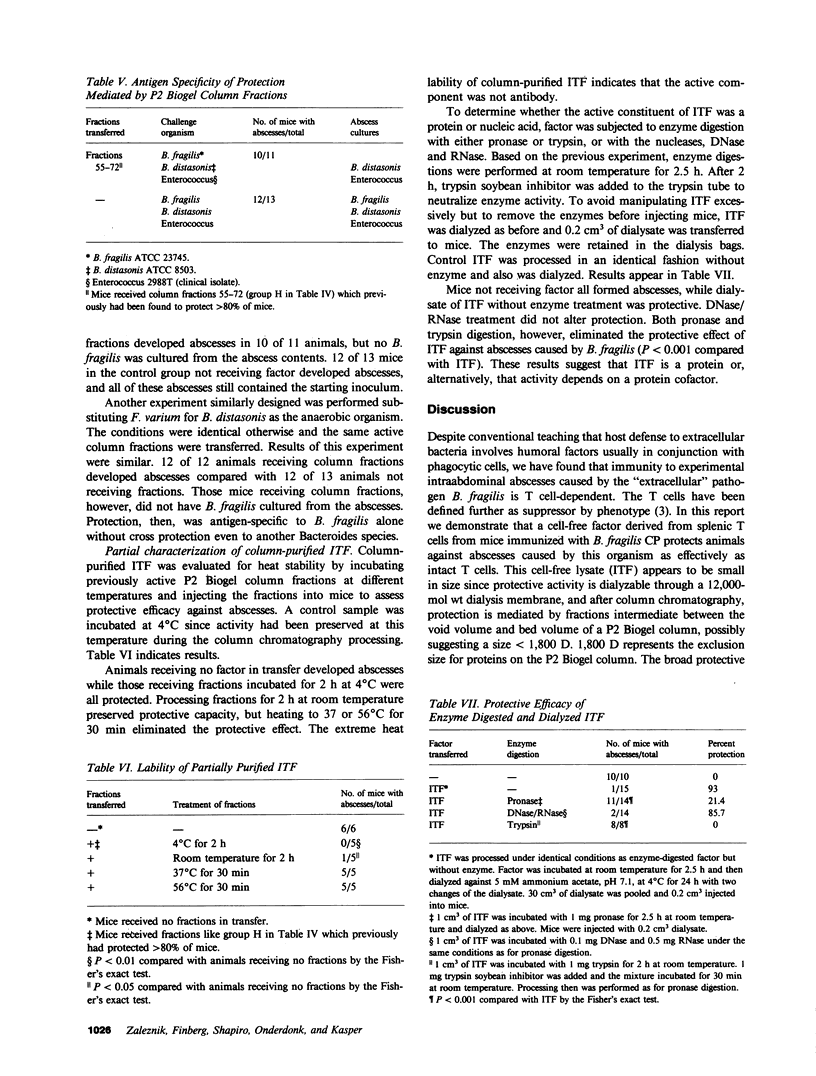Abstract
This paper describes a suppressor T cell factor which protects mice against intraabdominal abscesses caused by Bacteroides fragilis. This soluble cell-free factor (ITF) is derived from splenic T cells from mice immunized with capsular polysaccharide (CP) of B. fragilis. Mice receiving ITF are protected from developing abscesses caused by B. fragilis to the same degree as animals receiving intact immune splenic T cells. The factor appears to be small in molecular size as protective activity is dialyzable through a 12,000-mol wt exclusion dialysis membrane and is present in fractions intermediate between the bed and void volumes of a P2 Biogel column. The protective effect of ITF is antigen-specific to B. fragilis alone. Mice given a complex inoculum of B. fragilis, enterococcus, and another anaerobe develop abscesses even after receiving column-purified ITF. The activity of ITF also is eliminated after adsorption with B. fragilis CP coupled to sheep erythrocytes but not with an unrelated CP coupled to sheep erythrocytes. ITF, therefore, appears to have a binding site for B. fragilis CP. ITF is heat-labile and loses efficacy after protease digestion, suggesting that the active material is a protein. These studies define a suppressor cell factor with activity in a model system resembling human disease and offer promise for increased understanding of the diversity of cell-mediated immune systems.
Full text
PDF




Selected References
These references are in PubMed. This may not be the complete list of references from this article.
- Baker C. J., Kasper D. L., Davis C. E. Immunochemical characterization of the "native" type III polysaccharide of group B Streptococcus. J Exp Med. 1976 Feb 1;143(2):258–270. doi: 10.1084/jem.143.2.258. [DOI] [PMC free article] [PubMed] [Google Scholar]
- Baker P. J., Stashak P. W., Prescott B. Use of erythrocytes sensitized with purified pneumococcal polysaccharides for the assay of antibody and antibody-producing cells. Appl Microbiol. 1969 Mar;17(3):422–426. doi: 10.1128/am.17.3.422-426.1969. [DOI] [PMC free article] [PubMed] [Google Scholar]
- Benacerraf B., Greene M. I., Sy M. S., Dorf M. E. Suppressor T cell circuits. Ann N Y Acad Sci. 1982;392:300–308. doi: 10.1111/j.1749-6632.1982.tb36115.x. [DOI] [PubMed] [Google Scholar]
- Borkowsky W., Suleski P., Bhardwaj N., Lawrence H. S. Antigen-specific activity of murine leukocyte dialysates containing transfer factor on human leukocytes in the leukocyte migration inhibition (LMI) assay. J Immunol. 1981 Jan;126(1):80–82. [PubMed] [Google Scholar]
- Healy C. T., Kapp J. A., Webb D. R. Purification and biochemical analysis of antigen-specific suppressor factors obtained from the supernatant, membrane, or cytosol of a T cell hybridoma. J Immunol. 1983 Dec;131(6):2843–2847. [PubMed] [Google Scholar]
- Kasper D. L., Weintraub A., Lindberg A. A., Lönngren J. Capsular polysaccharides and lipopolysaccharides from two Bacteroides fragilis reference strains: chemical and immunochemical characterization. J Bacteriol. 1983 Feb;153(2):991–997. doi: 10.1128/jb.153.2.991-997.1983. [DOI] [PMC free article] [PubMed] [Google Scholar]
- Lawrence H. S., Borkowsky W. A new basis for the immunoregulatory activities of transfer factor--an arcane dialect in the language of cells. Cell Immunol. 1983 Nov;82(1):102–116. doi: 10.1016/0008-8749(83)90145-4. [DOI] [PubMed] [Google Scholar]
- Lifshitz R., Apte R. N., Mozes E. Partial purification and characterization of an antigen-specific helper factor synthesized by a T-cell continuous line. Proc Natl Acad Sci U S A. 1983 Sep;80(18):5689–5693. doi: 10.1073/pnas.80.18.5689. [DOI] [PMC free article] [PubMed] [Google Scholar]
- Murphy J. W., Mosley R. L., Moorhead J. W. Regulation of cell-mediated immunity in cryptococcosis. II. Characterization of first-order T suppressor cells (Ts1) and induction of second-order suppressor cells. J Immunol. 1983 Jun;130(6):2876–2881. [PubMed] [Google Scholar]
- Onderdonk A. B., Bartlett J. G., Louie T., Sullivan-Seigler N., Gorbach S. L. Microbial synergy in experimental intra-abdominal abscess. Infect Immun. 1976 Jan;13(1):22–26. doi: 10.1128/iai.13.1.22-26.1976. [DOI] [PMC free article] [PubMed] [Google Scholar]
- Onderdonk A. B., Markham R. B., Zaleznik D. F., Cisneros R. L., Kasper D. L. Evidence for T cell-dependent immunity to Bacteroides fragilis in an intraabdominal abscess model. J Clin Invest. 1982 Jan;69(1):9–16. doi: 10.1172/JCI110445. [DOI] [PMC free article] [PubMed] [Google Scholar]
- Shapiro M. E., Onderdonk A. B., Kasper D. L., Finberg R. W. Cellular immunity to Bacteroides fragilis capsular polysaccharide. J Exp Med. 1982 Apr 1;155(4):1188–1197. doi: 10.1084/jem.155.4.1188. [DOI] [PMC free article] [PubMed] [Google Scholar]
- Washington J. A., 2nd Comparison of two commercially available media for detection of bacteremia. Appl Microbiol. 1971 Oct;22(4):604–607. doi: 10.1128/am.22.4.604-607.1971. [DOI] [PMC free article] [PubMed] [Google Scholar]


